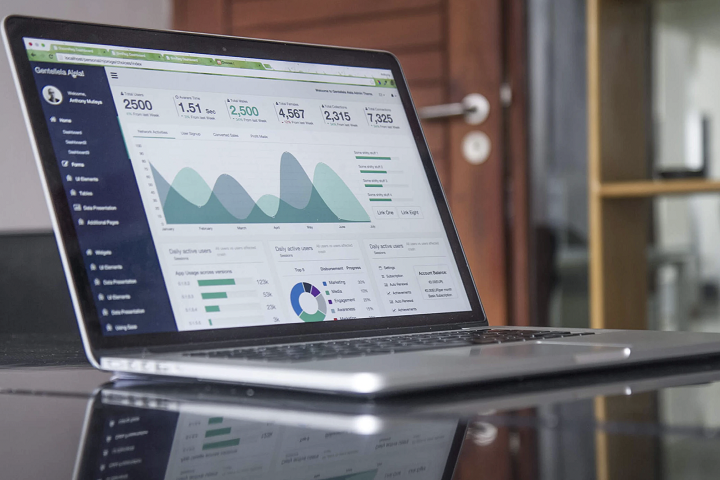Big Data
Data-Driven Strategies: Leveraging Analytics in NetSuite CRM and Sales Force Automation
We’ll delve into the world of data-driven strategies in sales and CRM, highlighting analytics’ pivotal role in achieving success. Leveraging analytics in NetSuite CRM and Salesforce automation

In today’s dynamic business landscape, the art of successful sales and customer relationship management (CRM) has evolved beyond intuition and gut feeling. The rise of data-driven strategies has reshaped how businesses engage with their customers, make informed decisions, and achieve growth. By harnessing the power of analytics, companies can unlock a wealth of insights that drive personalized customer experiences, strategic planning, and revenue optimization.
In this article, we’ll delve into the world of data-driven strategies in sales and CRM, highlighting analytics’ pivotal role in achieving success. We’ll explore how NetSuite CRM, with its seamless integration with sales force automation, empowers businesses to manage customer relationships and do so with strategic intelligence derived from data. So, let’s embark on this journey of understanding how analytics can be a game-changer in sales and CRM.
Table of Contents
1. Why Analytics Matter in Modern Sales and CRM
In an era where information is abundant and accessible, companies can tap into vast data reserves to drive their decision-making processes. Analytics, the systematic data analysis, provides the means to convert raw information into actionable insights. In sales and CRM, these insights are like golden nuggets that offer a deeper understanding of customer behavior, preferences, and pain points.
By leveraging analytics, businesses can move beyond generic interactions and engage customers personally. Understanding what customers genuinely want and need becomes possible, allowing companies to tailor their products, services, and communication accordingly.
2. NetSuite CRM: Where Analytics and Sales Force Automation Converge
At the heart of modern CRM and sales strategies lies NetSuite CRM, an integrated platform that seamlessly merges customer relationship management with the power of analytics. NetSuite’s robust suite of tools empowers businesses to not only manage customer interactions but also to derive valuable insights from these interactions. This synergy between CRM and analytics is a game-changer, transforming routine data into strategic decision-making fuel.
Integrating sales force automation within NetSuite CRM means that the entire sales process, from lead generation to closing deals, is backed by data-driven intelligence. Businesses can understand the journey of their prospects, identify trends, and tailor their strategies for optimal results.
3. The Power of Analytics in Sales and CRM
Data has emerged as the new currency in the ever-evolving business landscape, and its strategic utilization through analytics has become a critical differentiator. This section will delve into the profound impact of data analytics in sales and customer relationship management (CRM), shedding light on how analytics are revolutionizing decision-making and customer engagement.

4. The Significance of Data Analytics in the Modern Business Landscape
The digital era has ushered in an age of unprecedented data availability. Organizations are inundated with abundant information generated by customer interactions, transactions, social media, and various touchpoints. However, raw data alone has limited value. The true power lies in transforming this data into actionable insights through advanced analytics.
Data analytics empowers businesses to move beyond assumptions and base decisions on empirical evidence. It enables organizations to make informed choices, uncover hidden patterns, and predict future trends. In the context of sales and CRM, analytics provide a strategic advantage by enabling businesses to understand their customers deeper, anticipate their needs, and create targeted strategies that resonate.
5. Understanding Customer Behavior and Preferences
In the age of personalization, understanding customer behavior and preferences is paramount. This is where analytics shine. Businesses gain insights into customer journeys, interactions, and buying patterns by analyzing data collected from various touchpoints. Analytics help identify trends such as which products or services are most popular, which channels customers prefer, and what factors influence their decisions.
With this understanding, companies can tailor their offerings, messaging, and engagement strategies to align with customers’ desires. This level of customization not only enhances customer satisfaction but also increases the likelihood of conversions and long-term loyalty.
6. Driving Personalized Customer Experiences
Customer experience is the cornerstone of modern business success. Analytics elevate customer experiences by enabling hyper-personalization. Businesses can create detailed customer profiles that include preferences, purchase history, and interactions through data analysis. With this knowledge, sales teams can engage customers with relevant recommendations, targeted promotions, and personalized communication.
Whether it’s suggesting products based on past purchases or sending personalized follow-ups after an interaction, analytics empower businesses to deliver experiences that resonate on an individual level.
7. Gaining a Competitive Advantage Through Data-Driven Insights
In today’s fiercely competitive landscape, gaining an edge is imperative. This edge is achieved through data-driven insights that fuel intelligent decision-making. Companies that leverage analytics gain a comprehensive understanding of their market positioning, competitor strategies, and emerging trends.
By harnessing analytics, businesses can identify untapped market segments, optimize pricing strategies, and allocate resources where they yield the most significant impact. This proactive approach to decision-making offers a significant competitive advantage that propels growth and innovation.
8. Analytics in NetSuite CRM and Sales Force Automation
In this section, we will explore the robust analytics capabilities that NetSuite CRM offers and how they seamlessly integrate with sales force automation to empower businesses with actionable insights. By delving into the data types analyzed and the role of predictive analytics, we’ll uncover how NetSuite CRM propels organizations toward data-driven success.

9. Analytics Capabilities within NetSuite CRM
NetSuite CRM is not just a tool for managing customer relationships; it’s a comprehensive platform that harnesses the power of data analytics. Within the CRM framework, NetSuite offers a range of analytics features that enable businesses to derive valuable insights from their customer interactions, sales activities, and more. These analytics capabilities empower organizations to make informed decisions and optimize their sales strategies based on real-time data.
10. Integration of Sales Force Automation and Data Analytics
One of the standout strengths of NetSuite CRM is its seamless integration of sales force automation and data analytics. This integration creates a dynamic synergy between these critical components, allowing sales teams to leverage data-driven insights to enhance their strategies and interactions.
By merging the functionalities of sales force automation with analytics, NetSuite empowers sales professionals to align their efforts with customer behavior and preferences, ultimately leading to improved customer satisfaction and higher sales conversion rates.
11. Types of Data Collected and Analyzed
NetSuite CRM is designed to capture and analyze various data points that provide a comprehensive view of customer interactions and sales trends. This data encompasses customer profiles, historical purchases, communication history, social media interactions, and more. By collating and analyzing this wealth of information, NetSuite CRM equips businesses with a deep understanding of their customers’ journeys, enabling personalized engagement strategies that resonate on a meaningful level.
12. The Role of Predictive Analytics
Predictive analytics has become a cornerstone of successful sales strategies. NetSuite CRM harnesses the power of predictive analytics to forecast sales trends and identify valuable opportunities. By analyzing historical sales data, customer behaviors, and market trends, predictive analytics algorithms generate accurate predictions for future sales patterns.
This empowers sales teams to proactively adjust their strategies, allocate resources efficiently, and tailor their approach to capitalize on emerging opportunities. The ability to anticipate customer needs and market shifts provides a significant advantage in a competitive landscape.
13. Benefits of Data-Driven Strategies
This section will delve into the tangible benefits businesses can reap by embracing data-driven strategies through NetSuite CRM and sales force automation. From informed decision-making to personalized engagement, we’ll uncover how leveraging analytics can transform sales processes and enhance customer relationships.
Improved Decision-Making: How Analytics Guide Smarter Sales Decisions
At the heart of data-driven strategies lies the ability to make well-informed decisions backed by concrete insights. With NetSuite CRM’s analytics capabilities, sales teams gain access to a wealth of data that helps guide their decision-making process. Analytics enable sales professionals to identify trends, pinpoint successful strategies, and recognize areas for improvement.
By basing decisions on data rather than intuition alone, businesses can minimize risks, optimize resource allocation, and make decisions that align more closely with their objectives.

Enhanced Customer Understanding: Using Data to Gain Insights into Customer Preferences
Understanding customers is fundamental to successful sales and customer relationship management. NetSuite CRM’s analytics provide a comprehensive view of customer interactions, allowing businesses to delve into preferences, purchase history, communication patterns, and more.
Armed with this data, sales teams can craft targeted and relevant offers that resonate with customers personally. This enhanced understanding enables businesses to build stronger customer connections and anticipate their needs, fostering loyalty and repeat business.
Personalized Engagement: Tailoring Interactions Based on Data Insights
NetSuite CRM’s analytics facilitate the delivery of these experiences by providing insights that enable tailored engagements. By analyzing past interactions and preferences, sales teams can craft communications and offers that are highly relevant to each customer. This personalized approach enhances customer satisfaction and increases the likelihood of conversions and upselling opportunities.
Identifying Upselling and Cross-Selling Opportunities: Leveraging Analytics for Revenue Growth
Upselling and cross-selling are essential strategies for revenue growth. NetSuite CRM’s analytics empower sales teams to identify prime opportunities for both. By analyzing past purchasing behavior and understanding customer preferences, sales professionals can pinpoint products or services that complement customers’ purchases.
This strategic approach increases the average transaction value and showcases the brand’s attentiveness to customer needs, fostering long-term loyalty.
14. NetSuite CRM Analytics Features
In this section, we will take a closer look at the robust analytics features NetSuite CRM offers. From data visualization to user-friendly interfaces, we’ll explore how NetSuite CRM empowers businesses with the tools they need to transform data into actionable insights.
Analytics Tools and Features within NetSuite CRM
NetSuite CRM stands out for its comprehensive suite of analytics tools designed to provide businesses with deep insights into their sales and customer data. We’ll explore the various tools available, such as advanced reporting, predictive analytics, and data segmentation. By providing an overview of these features, businesses can understand how NetSuite CRM equips them with the tools necessary to make data-driven decisions.
Data Visualization Options, Reporting Capabilities, and Dashboards
Visualizing data is a crucial aspect of making insights accessible and comprehensible. NetSuite CRM offers a range of data visualization options, including charts, graphs, and interactive dashboards. We’ll discuss how businesses can create custom reports highlighting key metrics and trends, allowing quick and informed decision-making. Additionally, we’ll explore how dashboards provide a real-time snapshot of sales performance, customer interactions, and other critical metrics.
How Data Is Collected, Stored, and Transformed into Actionable Insights
Understanding the journey of data from collection to actionable insights is essential. We’ll explain how NetSuite CRM seamlessly collects data from various touchpoints, such as customer interactions, sales orders, and marketing campaigns. We’ll also explore how this data is stored securely in a centralized database and how NetSuite’s analytics engine transforms raw data into valuable insights that drive strategic decisions.
User-Friendly Interface for Accessing and Interpreting Analytics Data
Complex analytics tools can often be intimidating, but NetSuite CRM prides itself on offering a user-friendly interface that empowers users of all backgrounds. We’ll highlight the intuitive nature of NetSuite’s analytics interface, making it easy for sales teams to access, interpret, and act upon insights. This accessibility ensures that analytics aren’t limited to data experts but are accessible to anyone involved in the sales and customer relationship process.
15. Steps to Implement Data-Driven Strategies
This section will guide you through the practical steps to effectively integrate analytics into NetSuite CRM and sales force automation. Implementing data-driven strategies requires careful planning and execution, and we’ll break down the process to ensure a seamless transition toward leveraging the power of data.

16. Steps to Integrate Analytics into NetSuite CRM and Sales Automation
Integrating analytics into your CRM and sales automation processes is a strategic endeavor. We’ll provide a comprehensive roadmap outlining the steps to incorporate data analytics into your workflow seamlessly. This includes identifying data sources, selecting the right analytics tools, and ensuring compatibility with NetSuite CRM.
Address Data Collection, Integration, Analysis, and Interpretation
Successful implementation hinges on effectively managing data throughout its lifecycle. We’ll delve into the critical stages of data handling, from collection methods to integrating data from various sources into NetSuite CRM. Furthermore, we’ll explore the data analysis process, focusing on how businesses can extract meaningful insights from raw data. Understanding data’s journey from collection to interpretation is essential for making informed decisions.
Importance of Setting Clear Goals and KPIs Before Implementing Strategies
Implementing data-driven strategies begins with clear objectives. Before integrating analytics into your CRM and sales automation, we’ll emphasize the significance of setting concrete goals and Key Performance Indicators (KPIs). Defining what you aim to achieve with data insights helps guide your strategy and ensures that the analytics efforts align with your business’s objectives.
Challenges and Solutions
Implementing data-driven strategies has its challenges. This section explores businesses’ common challenges while integrating analytics into NetSuite CRM and sales force automation. Moreover, we’ll provide actionable solutions and best practices to help you navigate these challenges and ensure a successful data-driven transformation.
Common Challenges in Implementing Data-Driven Strategies
Embracing data-driven strategies can come with obstacles that organizations need to address. We’ll delve into the challenges businesses often need help with, such as data quality issues, resistance to change, and difficulties aligning analytics efforts with business goals. Understanding these challenges is crucial to mitigating their impact effectively.
While challenges are inevitable, solutions are within reach. We’ll present practical solutions and best practices to tackle each identified challenge. Whether implementing data cleansing processes, fostering a data-driven culture, or establishing clear communication channels, these solutions will empower businesses to navigate the path toward successful data integration.
Role of Training and Continuous Learning for Effective Use of Analytics Tools
Harnessing the full potential of analytics tools requires a skilled workforce. We’ll underline the importance of training and continuous learning for your team to effectively utilize NetSuite CRM’s analytics capabilities. Whether it’s data interpretation, dashboard navigation, or advanced analytics techniques, investing in training ensures that your team maximizes the benefits of the integrated tools.
Future Trends in CRM and Analytics
The world of data analytics and customer relationship management is ever-evolving. In this section, we’ll explore the exciting future trends reshaping the CRM and sales force automation landscape. By understanding these trends, businesses can position themselves to stay ahead in the competitive market and harness the power of cutting-edge technologies.
Emerging Trends in Data Analytics for CRM and Sales Automation
The field of data analytics is dynamic, with new trends continually emerging. We’ll delve into the latest developments influencing how businesses approach data-driven strategies. From real-time analytics to advanced segmentation techniques, we’ll showcase the trends shaping the future of customer relationship management.
The Potential of AI and Machine Learning in Enhancing Analytics
Artificial Intelligence (AI) and Machine Learning (ML) transform businesses’ analysis and utilization of data. We’ll explore the role of AI and ML in enhancing analytics capabilities within NetSuite CRM. From predictive analytics to personalized customer experiences, we’ll showcase how these technologies revolutionize data-driven decision-making.
Stay Updated on Advancements to Remain Competitive
NetSuite offers a comprehensive suite of solutions that empower businesses to excel in customer relationship management (CRM), enterprise resource planning (NetSuite ERP), and financial management. NetSuite CRM provides the tools to cultivate meaningful customer relationships, leverage data-driven insights, and drive personalized engagement. Seamlessly integrated with NetSuite ERP, businesses can optimize their operations, streamline processes, and achieve a unified view of their entire organization.
When considering the investment in NetSuite, it’s essential to recognize that the NetSuite cost structure is designed to accommodate businesses of all sizes. The subscription-based model offers scalability and flexibility, comprising a core platform, optional modules, and user licenses. The initial implementation fee ensures a smooth setup, and as your business evolves, you can activate new modules and add users, harnessing the agility of cloud software.
NetSuite’s cost lies in its features and capabilities and the transformation it brings to businesses. With data-driven strategies at the core of its offerings, NetSuite empowers informed decision-making, enhances customer understanding, enables personalized engagement, and identifies growth opportunities. This comprehensive suite provides the tools needed to navigate the challenges and opportunities of a dynamic business landscape.
Big Data
How To Use Histogram Charts for Business Data Visualization
One such tool for data visualization that stands out for its simplicity and effectiveness is the histogram. Keep reading to learn more about histogram charts.

Data visualization is an indispensable tool for businesses operating in the contemporary digital era. It enhances the understanding and interpretation of complex data sets, paving the way for informed decision-making. One such tool for data visualization that stands out for its simplicity and effectiveness is the histogram. Keep reading to learn more about histogram charts.
Table of Contents
1. Understanding the Basics of Business Data Visualization
Alt text: A person looking at different data visualizations on a computer before looking at a histogram chart.
Business data visualization is a multidisciplinary field merging statistical analysis and computer science fundamentals to represent complex data sets visually. It transforms raw data into visual information, making it more understandable, actionable, and useful.
Visualization tools such as histogram charts, pie charts, bar graphs, and scatter plots offer businesses a way to understand data trends, patterns, and outliers—essentially bringing data to life.
Whether you’re analyzing sales performance, forecasting market trends, or tracking key business metrics, data visualization can be a powerful tool for presenting data that might otherwise be overlooked.
2. Deciphering the Role of Histogram Charts in Data Analysis
Histogram charts are a superb tool for understanding the distribution and frequency of data. They are bar graphs where each bar represents a range of data values known as a bin or bucket. The height of each bar illustrates the number of data points that fall within each bucket.
Unlike bar graphs that compare different categories, histogram charts visually represent data distribution over a continuous interval or a particular time frame. This makes them invaluable for many business applications, including market research, financial analysis, and quality control.
By portraying large amounts of data and the frequency of data values, histogram charts provide an overview of data distribution that can aid in predicting future data trends. It helps businesses to spot patterns and anomalies that might go unnoticed in tabular data.
3. Key Steps To Create Effective Histogram Charts
Creating effective histogram charts involves steps, starting with data collection. You need to gather relevant and accurate data for the phenomenon you’re studying.

Next, you determine the bins and their intervals. Bins are data ranges, and their number depends on the level of detail you want from your histogram. It’s essential to keep bins equal in size to facilitate comparison.
Once you’ve structured your data and decided on the number of bins, the next step is to count how many data points fall into each bin. This is the basis of your histogram.
Finally, you draw the histogram with the bins on the x-axis and the frequency on the y-axis. Each bin is represented by a bar, the height of which represents the number of data points that fall into that bin.
4. Advantages of Using Histogram Charts for Business Data Visualization
Alt text: A person on a computer looking at multiple screens with histogram charts.
Histograms offer a host of advantages in the realm of business data visualization. They provide a clear, visual summary of large data sets, making it easier to digest and comprehend the data.
Histograms are also useful in identifying outliers or anomalies in data, which can be significant in industries such as finance and quality control, where an anomaly could signify a significant issue that needs to be addressed.
5. Real-world examples of Business Data Visualization Using Histogram Charts
Many businesses use histograms to visualize data. For instance, a retail company may use histograms to analyze customer purchase patterns, enabling them to identify peak shopping times, seasonality, and trends in customer preferences.
A manufacturing company might use histogram charts to monitor product quality. By analyzing the frequency of defects, they can identify the cause of the problem and take corrective actions faster.
Histograms are also widely used in the financial industry. Financial analysts use histogram charts to visualize the distribution of investment returns, helping them to understand the risk associated with an investment.
Histogram charts are crucial in business data visualization, offering clear and concise representations of large data sets.
-

 Instagram4 years ago
Instagram4 years agoBuy IG likes and buy organic Instagram followers: where to buy them and how?
-

 Instagram4 years ago
Instagram4 years ago100% Genuine Instagram Followers & Likes with Guaranteed Tool
-

 Business5 years ago
Business5 years ago7 Must Have Digital Marketing Tools For Your Small Businesses
-

 Instagram4 years ago
Instagram4 years agoInstagram Followers And Likes – Online Social Media Platform
















